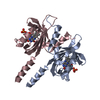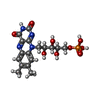+Search query
-Structure paper
| Title | Small-angle X-ray scattering study of the kinetics of light-dark transition in a LOV protein. |
|---|---|
| Journal, issue, pages | PLoS One, Vol. 13, Issue 7, Page e0200746, Year 2018 |
| Publish date | Jul 16, 2018 |
 Authors Authors | Katrin Röllen / Joachim Granzin / Renu Batra-Safferling / Andreas Maximilian Stadler /  |
| PubMed Abstract | Light, oxygen, voltage (LOV) photoreceptors consist of conserved photo-responsive domains in bacteria, archaea, plants and fungi, and detect blue-light via a flavin cofactor. We investigated the blue- ...Light, oxygen, voltage (LOV) photoreceptors consist of conserved photo-responsive domains in bacteria, archaea, plants and fungi, and detect blue-light via a flavin cofactor. We investigated the blue-light induced conformational transition of the dimeric photoreceptor PpSB1-LOV-R66I from Pseudomonas putida in solution by using small-angle X-ray scattering (SAXS). SAXS experiments of the fully populated light- and dark-states under steady-state conditions revealed significant structural differences between the two states that are in agreement with the known structures determined by crystallography. We followed the transition from the light- to the dark-state by using SAXS measurements in real-time. A two-state model based on the light- and dark-state conformations could describe the measured time-course SAXS data with a relaxation time τREC of ~ 34 to 35 min being larger than the recovery time found with UV/vis spectroscopy. Unlike the flavin chromophore-based UV/vis method that is sensitive to the local chromophore environment in flavoproteins, SAXS-based assay depends on protein conformational changes and provides with an alternative to measure the recovery kinetics. |
 External links External links |  PLoS One / PLoS One /  PubMed:30011332 / PubMed:30011332 /  PubMed Central PubMed Central |
| Methods | SAS (X-ray synchrotron) / X-ray diffraction |
| Resolution | 2.04 Å |
| Structure data |  SASDDE6:  SASDDG6:  PDB-6gg9: |
| Chemicals |  ChemComp-FMN:  ChemComp-HOH: |
| Source |
|
 Keywords Keywords | SIGNALING PROTEIN / blue light photoreceptor / Sensory box protein |
 Movie
Movie Controller
Controller Structure viewers
Structure viewers About Yorodumi Papers
About Yorodumi Papers



 Pseudomonas putida (strain atcc 47054 / dsm 6125 / ncimb 11950 / kt2440) (bacteria)
Pseudomonas putida (strain atcc 47054 / dsm 6125 / ncimb 11950 / kt2440) (bacteria)